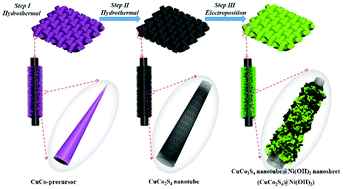A highly conductive Ni(OH)2 nano-sheet wrapped CuCo2S4 nano-tube electrode with a core–shell structure for high performance supercapacitors†
Abstract
The design of microstructures and the optimum selection of electrode materials have substantial effects on the electrochemical performances of supercapacitors. A core–shell structured CuCo2S4@Ni(OH)2 electrode material was designed, with CuCo2S4 nanotubes as the core wrapped by interlaced Ni(OH)2 nano-sheets as the shell. The hydrothermal and electro-deposition processes were adopted to synthesize CuCo2S4@Ni(OH)2 materials. The CuCo2S4 nanotubes can both provide specific capacitance and act as a “superhighway” for electrons due to their highly conductive skeleton structure. The Ni(OH)2 nano-sheets will boost the electrochemically active sites and enhance the specific surface area. Meanwhile, the mutually restricted core–shell CuCo2S4@Ni(OH)2 electrode could regulate the volume deformation to improve its stability. The CuCo2S4@Ni(OH)2 electrode had a maximum specific capacitance of 2668.4 F g−1 at a current density of 1 A g−1 and a superior cycling stability of 90.3% after 10 000 cycles. Moreover, a CuCo2S4@Ni(OH)2//active carbon asymmetric supercapacitor with a maximum energy density of 44 W h kg−1 was assembled, suggesting that CuCo2S4@Ni(OH)2 is a successful binder-free electrode material for high performance supercapacitors.



 Please wait while we load your content...
Please wait while we load your content...